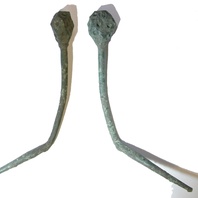
Viking Objects
Ring-and-Dot Pin (1986/976-SF4)
This copper alloy pin with a ring-and-dot pattern on the head was used for fastening cloaks. It was found on the site of Little Chester Roman fort. Pins like this were common in Ireland and the western British Isles, and spread further afield under Viking influence.
Read More
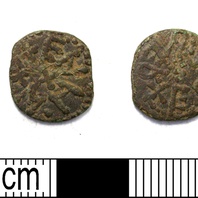
Viking Objects
Northumbrian Styca (LEIC-0D9D6F)
This Northumbrian styca was probably minted in the name of Æthelred II of Northumbria possibly by the moneyer Eanwulf. While Wessex and Mercia were using silver coinage as part of their monetary economy, Northumbria was using copper coins known as stycas, which may have contained trace amounts of silver. The concentration of these coins at sites such as Torksey and ARSNY (‘a riverine site near York’) suggests that they could have remained in circulation after the fall of Northumbria in 866 but were taken to these sites by the Vikings during their campaigning. This particular example was likely brought to Nottinghamshire from Northumbria by means of the Great Army’s overwintering activities in and around Nottingham.
Read More
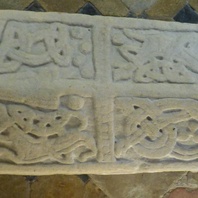
Viking Objects
The Hickling Hogback
The Hickling hogback is a type of Anglo-Scandinavian grave cover in St Luke’s Church, Hickling, Nottinghamshire. It is the most southerly grave cover of this type in England. It appears to have been carved from the remains of a Roman column, hence the notch in the end of it. The stone features Scandinavian Jelling-style decoration indicating an expression of Scandinavian identity and muzzled bears on each end which are thought to be indicators of a pagan identity. However, the stone also features a large cross showing that the commissioners of the carving had a strong interest in expressing the Christian identity of the deceased. As such, this stone is designed to show that the person buried under it was a Christian Scandinavian.
Read More
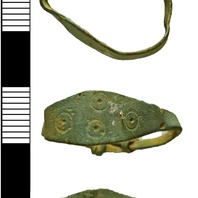
Viking Objects
Stamped Finger-Ring (NARC-031C88)
A stamped copper-alloy finger ring decorated with four double ring-and-dots in a lozengiform arrangement. Ring-and-dot was a decorative technique used at various periods from the later Iron Age onwards, but which enjoyed a Viking Age revival. Rings like this with knotted ends are typically Scandinavian.
Read More
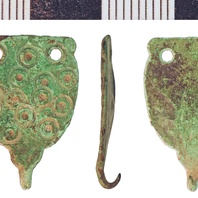
Viking Objects
Hooked Tag (NLM-8E96D5)
This example of an Anglo-Scandinavian copper-alloy hooked tag is classed as a Read Class A Type 1 or Class B Type 1. The tag is decorated with a stamped ring-and-dot motif which was a popular style among Scandinavians.
Read More
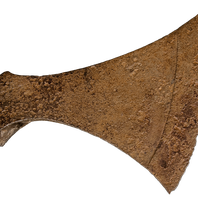
Viking Objects
Socketed Axe (LCNCC:1906.9661.2)
This large socketed iron axe head was found in the River Witham, east of Lincoln, Lincolnshire. Axes were not only a common implement used for a variety of wood-based activities, such as constructing ships, but also were often used as weapons. Axes came in a variety of shapes and sizes depending on their function. Considering the size and shape, this axe was most likely used for warfare rather than as a tool.
Read More
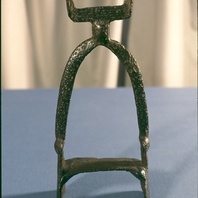
Viking Objects
Stirrup (LCNCC : 1906.9663)
A large iron stirrup of Viking type with a long slender looped form, rectangular terminal, and a flat footrest. It was found in the River Witham near Lincoln. Stirrups like this were an innovation that Scandinavian settlers introduced to Anglo-Saxon England in the eleventh century.
Read More
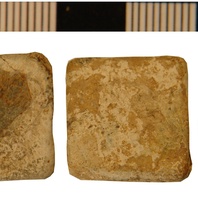
Viking Objects
Square Lead-Alloy Weight (NLM-941282)
Weights are an important form of evidence for Viking Age commerce and the use of standards across the different economic systems within which Vikings were integrated. Many of the weights discovered, particularly ones in Ireland and those of Arabic type, suggest that a standardized system of weights existed in some areas. These standard weights, alongside standard values of silver, are what allowed the bullion economy of Viking occupied areas to function. A bullion economy was a barter economy that relied on the exchange of set amounts of precious metal in various forms, such as arm-rings or coins, for tradable goods, such as food or textiles. Each merchant would have brought their own set of weights and scales to a transaction to make sure that the trade was conducted fairly.
Read More
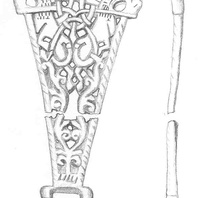
Viking Objects
Harness Fitting (NLM168)
This harness fitting, now broken into two parts, is trapezoidal in shape with two strap loops and is decorated with elaborate interlace decoration. The main element consists of two adorsed animals, possibly horses, set within a field of plant interlace.
Read More
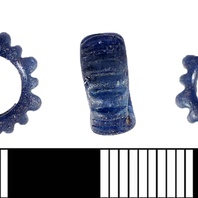
Viking Objects
Glass Bead (PUBLIC-170BD9)
This monochrome glass bead is blue coloured and has a decorative edging in a reed like pattern. Similar beads have been found in other Anglo-Scandinavian contexts. Glass beads were, generally, used in necklaces or similar jewellery and were highly prized among Scandinavians.
Read More
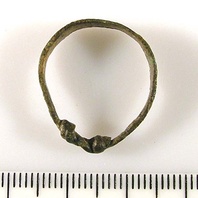
Viking Objects
Copper-Alloy Finger-Ring (LIN-E42F77)
The ring is formed by a flat band tapering to ends which have been knotted together. The outer face of the band is decorated with a row of punched ring and dot motifs.
